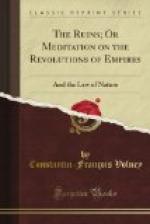rains which deluge the earth during the dominion of
that star. At a later period,*** in Persia,****
it was the Serpent, who, under the name of Abrimanes,
formed the basis of the system of Zoroaster; and it
is the same, O Christians and Jews! that has become
your serpent of Eve (the celestial virgin,) and that
of the cross; in both cases it is the emblem of Satan,
the enemy and great adversary of the Ancient of Days,
sung by Daniel.
* The ancient priests
had three kinds of spheres, which it
may be useful to make
known to the reader.
“We read in Eusebius,” says Porphyry, “that Zoroaster was the first who, having fixed upon a cavern pleasantly situated in the mountains adjacent to Persia, formed the idea of consecrating it to Mithra (the sun) creator and father of all things: that is to say, having made in this cavern several geometrical divisions, representing the seasons and the elements, he imitated on a small scale the order and disposition of the universe by Mithra. After Zoroaster, it became a custom to consecrate caverns for the celebration of mysteries: so that in like manner as temples were dedicated to the Gods, rural altars to heroes and terrestrial deities, etc., subterranean abodes to infernal deities, so caverns and grottoes were consecrated to the world, to the universe, and to the nymphs: and from hence Pythagoras and Plato borrowed the idea of calling the earth a cavern, a cave, de Antro Nympharum.
Such was the first projection of the sphere in relief; though the Persians give the honor of the invention to Zoroaster, it is doubtless due to the Egyptians; for we may suppose from this projection being the most simple that it was the most ancient; the caverns of Thebes, full of similar pictures, tend to strengthen this opinion.
The following was the second projection: “The prophets or hierophants,” says Bishop Synnesius, “who had been initiated in the mysteries, do not permit the common workmen to form idols or images of the Gods; but they descend themselves into the sacred caves, where they have concealed coffers containing certain spheres upon which they construct those images secretly and without the knowledge of the people, who despise simple and natural things and wish for prodigies and fables.” (Syn. in Calvit.) That is, the ancient priests had armillary spheres like ours; and this passage, which so well agrees with that of Chaeremon, gives us the key to all their theological astrology.
Lastly, they had flat models of the nature of Plate V. with the difference that they were of a very complicated nature, having every fictitious division of decan and subdecan, with the hieroglyphic signs of their influence. Kircher has given us a copy of one of them in his Egyptian Oedipus, and Gybelin a figured fragment in his book of the calendar (under the name of the Egyptian Zodiac). The ancient Egyptians, says the




